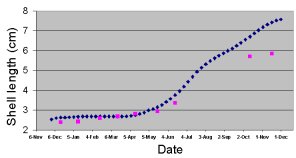Results and outcomes
Carrying capacity and impact of aquaculture on the environment in Chinese bays
INCO-DC contract Nš ERBIC4CT 98-0291
Elements of our models defining shellfish responses are cutting edge, with novel approaches that we expect will be applied widely. In particular, for the first time in such models, we have resolved significant adjustments in the relative processing of living chlorophyll-rich phytoplankton organics, non-phytoplankton organics and the remaining inorganic matter during both differential retention on the gill and selective pre-ingestive rejection within pseudofaeces.
|
|
We also include a facility to simulate the energy content of non-phytoplankton organics. This is significant, for that energy content was very much more variable than for phytoplankton organics, and which represented less than 20% of all suspended particulate organic matter.
Such resolution of the relative processing of different particle types allows simulation of how the rates, organic compositions and energy contents of filtered, ingested and deposited matter change in response to wide differences in seawater temperature, seston availability and seston composition. |
Dependent relations predict rates of energy absorption, energy expenditure and excretion. By these means, our models are more adaptable that past models of shellfish physiology, replicating dynamic adjustments in feeding and metabolism across full ranges of relevant natural variability, and successfully simulating growth from larvae or seed to harvestable size under different temporal and spatial scenarios of culture.
| This is an important advance compared with simpler models that do not simulate responsive adjustments, for only by modeling the complex set of feedbacks, both positive and negative, whereby suspension feeding shellfish interact with ecosystem processes, can one realistically hope to assess environmental capacities for culture. |
|
Measurements and simulations of the effects of culture on hydrodynamics indicated that disregard for physical barriers associated with culture will result in a serious overestimation of the particle renewal term and thus an overestimation of carrying capacity. Coupling our models of bivalve ecophysiology and one-dimensional hydrodynamics, the resulting depletion model for use by farm managers demonstrated how shellfish density has an increasingly negative effect on growth in regions with higher water residence times or lower depths, and which may be used to establish optimal densities for aquaculture at different locations throughout the bay.
Our coupled bay-scale models were used to simulate various culture scenarios, each scenario representing a whole cultivation cycle, whilst depicting differences in time of seeding and/or harvesting, according to recent changes in aquaculture practice, including different spatial distributions and/or densities of the main cultivated species. Findings establish how coupled models of this kind are increasingly able to simulate the general behaviour of key ecosystem variables, both in space and time, at least within the context of this relatively simple marine system, dominated by a few species.
Main innovative findings within the content of community ecology generally include how very sensitive total production can be to changes in the composition, densities and/or distributions of dominant cultured species, where changes in local density may have effects at the bay scale.
|
|
Collective findings from different simulations using both our 2D and box models at bay-scale suggest that Sanggou Bay is already being exploited close to the environmental carrying capacity for scallop production, albeit with some potential for increased oyster production. This reflects inter-specific competition for food, with a competitive advantage for oysters compared with scallops, despite being cultivated in different areas of the bay. |
Given apparent limitations on harvest yield for scallops, a hypothetical scenario was requested by local managers to assess whether scallop production might be increased without changing bivalve loads, in which the total quantity of scallops and oysters remained the same as present, but when the scallops are distributed over the area currently given over for cultivation of both scallops and kelp, thereby creating areas of combined kelp and scallop culture, in which average scallop density is reduced. Predictions under this suggested alternative management strategy suggest that harvest yields that oyster yield would be maintained, yet scallop production increased by more than three fold. This represents an increase of nearly 50% in the total combined yield of shellfish in comparison with current aquaculture scenario. The change is consistent with past observations whereby similar combinations of scallop and kelp culture have proven successful elsewhere, and which we now understand is being trialled in Sanggou Bay.
Our approach is generic in the sense that modelling tools and concepts can be applied to other sites and cultivated species. Tools and concepts were widely discussed and disseminated within the consortium. Databases, Geographic Information Systems and models remain available for use by others as indicated in the project's Technology Implementation Plan.


